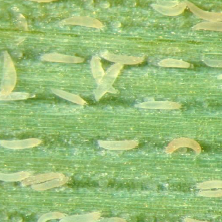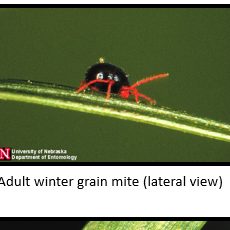
Hot Topics in Integrated Pest Management
When and Where Slugs Can Be a Problem in Soybeans?: youtube.com/watch?v=yJAiut5IHqY
Integrated Pest Management (IPM) is a process consisting of the balanced use of cultural, biological, and chemical procedures that are environmentally compatible, economically feasible, and socially acceptable to reduce pest populations to tolerable levels.

Stink Bugs: Corn and Soybeans
One of the first tasks assigned to the irrigation research team by Delaware farmers was to answer the decades-old question of how to best irrigate corn on sandy soils for maximum yield. Our initial research began using an evapotranspiration (ET) based schedule to determine when the crop should be irrigated, and looked at applying the water in varying amount per application. The application rates during peak water use were 0.33″ per day vs. 0.66″ every other day vs. 1′ every three days. The results of the initial work was rather inconclusive as soil type appeared to make more of a difference than application method. At this point, it became obvious to begin looking at varying amounts of irrigation across a range of soil types.

Slugs: Field Crops
Unfortunately, slugs in soybeans can be challenging to manage. The reason for this is that slugs will feed on soybeans before they emerge and kill the plants outright. In many cases, you don’t realize you have a slug problem until you return to a field, 7-14 days after planting, expecting to see a beautiful stand of soybeans, only to find that you have poor emergence or that you don’t have a stand at all.
- Biology and Management of Slugs on Field Crops
- Slug ID Guide
- High Residue IPM Working Group (HRIPM)
- How Well Does Slug Bait Work? Virginia Tech
- Slug Management in Continuous No-Till, Virginia Tech
- Effects of Vertical Tillage on Slugs
- Evaluation of Lannate LV to Control Slugs in No-Till Corn- 2010 and 2012

Cereal Rust Mite
Cereal rust mite adults are small measuring less than one millimeter (mm), and for the first time observer a 10‐20X hand lens is needed to see them. The mites are cigar‐shaped and roughly twice as long as they are wide. Adult mites are often light yellow but can be white or orange in color.

Winter Grain Mite in Small Grains
The winter grain mite is a cool season pest of small grains and orchard grass. The adult mite is approximately 1 mm long with a dark brown to black body, reddish‐orange legs, and it has a reddish‐orange spot on the top side of the body.
Other Related Fact Sheets
All Results
-
SOYBEAN VEIN NECROSIS VIRUS
Soybean Vein Necrosis Virus is an Orthotospovirus. This virus can be seed borne or vectored by multiple thrips species.
-
ALFALFA WEEVIL CONTROL IN ALFALFA
The alfalfa weevil (AW) overwinters in both the adult and egg stages. Although egg laying occurs in the fall and spring, larvae hatching from spring-laid eggs cause the most damage. Eggs are laid in the alfalfa stem any time temperatures are above 48 degrees F.
-
ALFALFA WEEVIL CONTROL IN ALFALFA (Section 2)
The alfalfa weevil (AW) overwinters in both the adult and egg stages. Although egg laying occurs in the fall and spring, larvae hatching from spring-laid eggs cause the most damage.
- 1
- 2
- 3
- 4
- 5
- 6
- 7
- >>






























